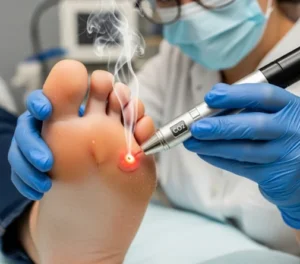Overview
Surgery for large hiatus hernia is a medical procedure to repair a hiatal hernia, where a portion of the stomach pushes through the diaphragm into the chest cavity, causing heartburn, regurgitation, difficulty swallowing, or chest pain. Large hernias may lead to serious complications such as gastric volvulus, obstruction, or chronic reflux.
In Korea, this surgery is performed in specialized gastroenterology and upper GI surgery centers, using minimally invasive laparoscopic or robotic-assisted techniques, ensuring effective repair, reduced complications, and rapid recovery.
What is Surgery for Large Hiatus Hernia?
The surgical procedure involves reducing the herniated stomach into the abdominal cavity and repairing the diaphragmatic opening (hiatus).
Common surgical approaches include:
- ✦ Laparoscopic Nissen fundoplication: wrapping the upper part of the stomach around the lower esophagus to reinforce the sphincter.
- ➤ Partial fundoplication (Toupet or Dor): used for specific cases to reduce reflux while preserving swallowing function.
- ✦ Hiatal repair with mesh reinforcement: strengthening the diaphragmatic opening to prevent recurrence.
- ➤ Robotic-assisted surgery: enhances precision, reduces trauma, and speeds up recovery.
The primary goal is to eliminate reflux symptoms, restore normal anatomy, and prevent life-threatening complications.
What are the Benefits?
Surgery for large hiatus hernia provides several advantages:
✅ Relieves severe heartburn, regurgitation, and chest pain.
➤ Prevents complications such as gastric obstruction, volvulus, or Barrett’s esophagus.
✦ Minimally invasive techniques reduce pain, scarring, and hospital stay.
➤ Improves quality of life and allows normal eating habits.
✅ Low recurrence rates when performed by experienced surgeons.
✦ Robotic-assisted options offer enhanced precision and shorter recovery.
Procedure Details
1) How should I prepare for Surgery for Large Hiatus Hernia?
Preparation steps include:
- ✦ Medical evaluation: review medical history, medications, allergies, previous abdominal surgeries.
- ➤ Diagnostic tests: upper endoscopy, barium swallow, esophageal manometry, and CT scan to assess hernia size and esophageal function.
- ✦ Laboratory tests: blood count, electrolytes, kidney and liver function tests.
- ➤ Medication adjustments: stop anticoagulants or anti-inflammatory medications if advised.
- ✦ Fasting instructions: typically 6–8 hours before surgery.
- ➤ Consent and counseling: discussion of procedure type, anesthesia (usually general), risks, benefits, and recovery expectations.
2) What happens during the procedure Surgery for Large Hiatus Hernia?
The procedure is performed under general anesthesia:
➤ Step 1: Patient is positioned supine, abdomen prepped, and sterilized.
✦ Step 2: Laparoscopic or robotic ports are inserted for instrument access.
➤ Step 3: The herniated stomach and any other abdominal contents are reduced back into the abdominal cavity.
✦ Step 4: The diaphragmatic hiatus is repaired, sometimes reinforced with surgical mesh to prevent recurrence.
➤ Step 5: Fundoplication (wrapping the stomach around the esophagus) is performed to strengthen the lower esophageal sphincter.
✦ Step 6: Ports are removed, incisions closed, sterile dressings applied, and patient monitored in recovery.
Minimally invasive approaches in Korea reduce tissue trauma, shorten hospital stay, and accelerate recovery.
3) What happens after Surgery for Large Hiatus Hernia?
Postoperative care includes:
- ✦ Monitoring: vital signs, oxygen levels, and pain assessment.
- ➤ Pain management: oral or IV analgesics as prescribed.
- ✦ Diet progression: start with liquids, then soft foods, gradually advancing as tolerated.
- ➤ Wound care: keep incision sites clean and dry; watch for infection.
- ✦ Activity guidance: avoid heavy lifting, straining, or vigorous activity for several weeks.
- ➤ Follow-up visits: assessment of wound healing, swallowing function, and overall recovery.
Most patients resume normal daily activities within 2–4 weeks, with complete recovery and symptom resolution over several weeks.
Risks / Benefits
Potential Risks:
- ✦ Infection at the surgical site.
- ➤ Bleeding or hematoma formation.
- ✦ Dysphagia (difficulty swallowing) post-surgery.
- ➤ Gas bloating or temporary inability to belch.
- ✦ Rare complications: injury to esophagus, stomach, or surrounding organs.
Benefits:
- ✅ Resolves reflux and heartburn symptoms.
- ✅ Prevents serious complications such as obstruction or volvulus.
- ✅ Minimally invasive techniques shorten recovery and reduce pain.
- ✅ Low recurrence rates with mesh reinforcement and skilled surgery.
- ✅ Enhances quality of life, normal eating, and daily function.
Recovery and Outlook
Recovery after large hiatus hernia surgery generally includes:
- ➤ Hospital stay: 2–5 days depending on surgery type and patient condition.
- ✦ Pain management: controlled with prescribed medications.
- ➤ Diet progression: liquids initially, then soft foods, gradually returning to normal diet.
- ✦ Activity: light activity immediately; avoid heavy lifting or straining for 4–6 weeks.
- ➤ Long-term outcome: most patients experience complete resolution of reflux, improved quality of life, and minimal recurrence risk.
When To Call the Doctor
Contact your healthcare provider if you notice:
⚠ Severe chest or abdominal pain.
⚠ Persistent vomiting or inability to swallow.
⚠ Fever, redness, or discharge from incision sites.
⚠ Severe bloating, constipation, or abdominal swelling.
⚠ Recurrence of reflux symptoms or difficulty swallowing after recovery.
Best Korea Option / Process
Korea provides world-class surgery for large hiatus hernia with:
- ✦ Expert upper GI and laparoscopic surgeons with extensive experience in fundoplication and hernia repair.
- ➤ Advanced imaging and diagnostic tools for precise surgical planning.
- ✦ Minimally invasive and robotic-assisted techniques for fast recovery and reduced pain.
- ➤ Comprehensive pre- and post-operative care including diet counseling, pain management, and rehabilitation.
- ✦ Safe and effective procedures for both international and domestic patients.
- ➤ Multidisciplinary support including nursing, nutrition, and physiotherapy for optimal recovery.
Korea ensures patients receive safe, precise, and effective treatment for large hiatus hernia with minimal complications and excellent long-term outcomes.
Highlights of Surgery for Large Hiatus Hernia in Korea
- ✅ Minimally invasive laparoscopic and robotic-assisted options.
- ➤ Resolves reflux and heartburn effectively.
- ✦ Prevents serious complications like obstruction or volvulus.
- ➤ Reduced hospital stay and faster recovery.
- ✅ Comprehensive pre- and post-operative care for optimal outcomes.













